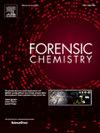Modification of screen-printed electrodes using gold nanostructures for SERS detection of low explosives
IF 2.6
3区 医学
Q2 CHEMISTRY, ANALYTICAL
引用次数: 0
Abstract
This study explores a novel application of surface-enhanced Raman spectroscopy (SERS) as a highly sensitive analytical tool for forensic analysis. We utilized a screen-printed gold electrode (SPGE) as a SERS active material, integrated with a portable Raman instrument for the rapid detection of low explosives. To enhance sensitivity while ensuring ease of handling, we conducted ex situ electrodeposition of gold nanostructures on the SPGE surface prior to analysis. The targeted molecules, comprising potassium nitrate (KNO3), potassium perchlorate (KClO4), sodium benzoate (C6H5COONa), diphenylamine (DPA) with its nitro derivatives, methyl centralite (MC) and ethyl centralite (EC), were studied using the proposed methodology. The developed system successfully provided distinctive SERS spectra fingerprints for low explosives (black powder, black powder substitutes, and smokeless powder) within seconds of analysis time. This approach holds promise for rapid, efficient, and accurate forensic analysis in real-world scenarios.

用金纳米结构修饰丝网印刷电极用于低炸药的SERS检测
本研究探索了表面增强拉曼光谱(SERS)作为法医分析的高灵敏度分析工具的新应用。我们利用丝网印刷金电极(SPGE)作为SERS活性材料,与便携式拉曼仪器集成,用于快速检测低炸药。为了提高灵敏度,同时确保易于操作,我们在分析之前在SPGE表面进行了金纳米结构的非原位电沉积。采用该方法研究了硝酸钾(KNO3)、高氯酸钾(KClO4)、苯甲酸钠(C6H5COONa)、二苯胺(DPA)及其硝基衍生物甲基中心石(MC)和乙基中心石(EC)。所开发的系统在几秒钟的分析时间内成功地为低炸药(黑火药、黑火药替代品和无烟火药)提供了独特的SERS光谱指纹。这种方法有望在现实场景中实现快速、高效和准确的法医分析。
本文章由计算机程序翻译,如有差异,请以英文原文为准。
求助全文
约1分钟内获得全文
求助全文
来源期刊

Forensic Chemistry
CHEMISTRY, ANALYTICAL-
CiteScore
5.70
自引率
14.80%
发文量
65
审稿时长
46 days
期刊介绍:
Forensic Chemistry publishes high quality manuscripts focusing on the theory, research and application of any chemical science to forensic analysis. The scope of the journal includes fundamental advancements that result in a better understanding of the evidentiary significance derived from the physical and chemical analysis of materials. The scope of Forensic Chemistry will also include the application and or development of any molecular and atomic spectrochemical technique, electrochemical techniques, sensors, surface characterization techniques, mass spectrometry, nuclear magnetic resonance, chemometrics and statistics, and separation sciences (e.g. chromatography) that provide insight into the forensic analysis of materials. Evidential topics of interest to the journal include, but are not limited to, fingerprint analysis, drug analysis, ignitable liquid residue analysis, explosives detection and analysis, the characterization and comparison of trace evidence (glass, fibers, paints and polymers, tapes, soils and other materials), ink and paper analysis, gunshot residue analysis, synthetic pathways for drugs, toxicology and the analysis and chemistry associated with the components of fingermarks. The journal is particularly interested in receiving manuscripts that report advances in the forensic interpretation of chemical evidence. Technology Readiness Level: When submitting an article to Forensic Chemistry, all authors will be asked to self-assign a Technology Readiness Level (TRL) to their article. The purpose of the TRL system is to help readers understand the level of maturity of an idea or method, to help track the evolution of readiness of a given technique or method, and to help filter published articles by the expected ease of implementation in an operation setting within a crime lab.
 求助内容:
求助内容: 应助结果提醒方式:
应助结果提醒方式:


